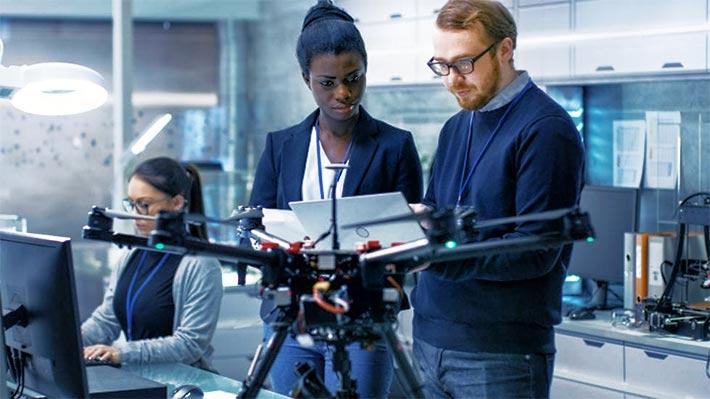
Near-field measurements eliminate special FAA waivers, reduce impact of signal reflections on measurements for broadcasters seeking to verify antenna radiation characteristics. Photo: Dielectric
Dielectric has launched a new engineering service that enables drone operators to fully and accurately characterize antenna azimuth and elevation performance without special waivers from the FAA. The service has been successfully beta-tested and is now in production at several broadcast tower sites.
The new service is a response to a common dilemma facing drone operators: To fully characterize an antenna’s elevation pattern, the drone flight must be performed in the elevation far-field, approximately several thousand feet from the antenna. Applications for FAA waivers have been stalled for more than 18 months in some cases, preventing the drone operator from completing measurements verifying antenna performance.
The less-attractive alternatives for broadcasters include close-in flights, which are accurate for azimuth only; or the less accurate and time-intensive ground-based techniques. Since the field measurements are reimbursable for “repacked” broadcasters in the USA, the delay in obtaining an FAA waiver can result not only in a repack project dragging on much longer than necessary, but also in the delayed identification of installation problems.
Dielectric engineers recognized that a new approach was needed. Realizing that no special waivers were required from the FAA for drone flights within the tower structure shield, Dielectric devised a method to confirm the antenna’s far-field elevation pattern, in addition to the azimuth pattern, from data gathered within that shield. This technique has an added advantage since far-field measurements are subject to signal reflections, multipath and interference, as are the more complicated ground-vehicle measurements.
“FAA rules place several restrictions on flying drones for commercial use. There is a 400-feet altitude restriction on commercial drone flights, unless the operator can fly the drone within a 400-foot radius around a structure, and does not fly higher than 400 feet above the top of that structure,” said John Schadler, Vice President of Engineering, Dielectric.
“Unfortunately, waivers for these rules take many months to process, and may never be granted due to other restrictions. Our technique solves the problem of getting a waiver beyond the FAA shield. That means no need to create flight plans and safety simulations, among other requirements that lengthen the approval process,” said Schadler.
Both near-field and far-field measurements allow broadcasters to verify azimuth radiation patterns for their TV antennas, and confirm that they are radiating as predicted and oriented properly on the tower. Dielectric’s approach calculates the near-field elevation pattern characteristics for comparison to the near-field drone measurement data, thus allowing a near-field measurement to accurately reflect elevation far-field performance.
Flight Preparation
Prior to a drone pilot taking flight, Dielectric engineers construct a full virtual model of the entire antenna, including tower support structure, based on final antenna and tower drawings. Using the company’s sophisticated high-frequency modeling software with the virtual model produces a detailed prediction of azimuth and elevation data at a given distance from the tower – at or within the 400-foot FAA limit. That allows a comparison of the virtual model with the actual near-field measurement, which is, in fact, an unfocused representation of what the radiation characteristics look like in the far-field.
The drone pilot then collects the data and returns it to Dielectric, where engineers export and plot the data over the virtual model. Once compared and confirmed, a report is provided to the end customer, which is typically a TV station engineer or consultant representing the broadcaster.
“The ability to compare near-field measurements with the virtual antenna model confirms that measurements in the far field would return the same data but, just to be sure, we carried out far-field drone measurements as well. The results matched,” said Nicole Starrett, Electrical Engineer, Dielectric. “The added benefit is that the antenna characteristics can be quickly transformed to any distance, near or far, for comparison. ”
Starrett adds that Dielectric has the ability to model any antenna for which they have detailed drawings and data, which means the service will most likely be restricted to Dielectric antennas. “Dielectric had more than 80 percent of the repack business in the USA over the past three years,” said Schadler. “That takes our total number of repack antennas shipped to 948, so we expect to be quite busy supporting this new service.”
Starrett will present Near Field Drone Measurements of Broadcast Antennas on October 15 at the Wisconsin Broadcasters Fall virtual event, as well as virtually at the Radio Club of America Technical Symposium on November 20.

















